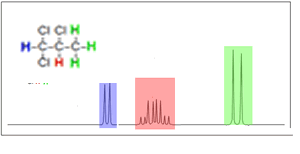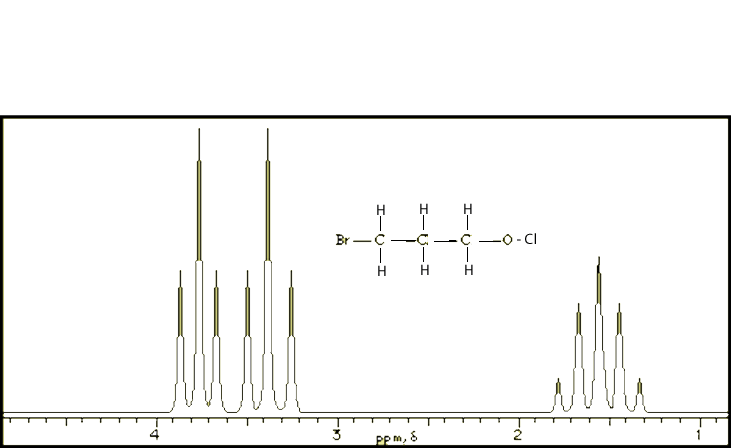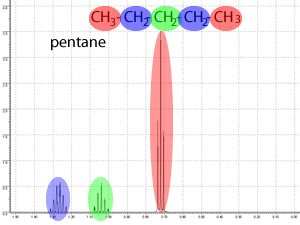Multiplicities- NMR
For the questions that the VCE course will ask of students the n+1 rule is sufficient, but, it is worth noting that this is a very simplified rule and a basic attempt is offered below to try and show a little of the complexity that lies behind the NMR spectroscopy.
splits the proton's signal
When a given nucleus has its signal split by two or more sets of nuclei the peaks are separated by a distance called the coupling constant, and given the symbol J. If neighbouring nuclei are chemically different, then each peak in the signal is separated by different J values and the n+1 rule fails to predict the entire splitting pattern.
No coupled hydrogens
One coupled hydrogen
Two coupled hydrogens
Three coupled hydrogens

Splitting is multiplicative.
Take the example of 1,1,2 trichloropropane. Its H NMR is shown on the right.
The hydrogen shown in the red has it signal split into 8 peaks or in other words a doublet of quartets. This doublet of quartets occurs when the green hydrogens, as pictured on the right, split the red signal into a quartet then the blue hydrogen further splits this quartet in a doublet of quartets having 8 peaks.
In other words (n+1) X (n+1) = 2 X 4 = 8 peaks.

Sometimes the resolution of the spectrum is not high enough to show the extra peaks and appears as though the n+1 rule works nicely. See below.
The middle CH2 group is surrounded by two CH2 that are not chemically equivalent hence the splitting should produce 9 peaks (3 X 3 =9). The spectrum on the other hand shows 5peaks that conveniently fit into out naive n+1 rule. A closer examination of the spectrum at a higher resolution reveals the 9 peaks.


1) Draw the structure of 1-chloropentane
2) How many peaks will the signal from the hydrogens on the 3rd carbon be split into?
solution
3) Consider the molecule CH2BrCH2CH2Cl
a) How many sets of peaks will be present in the H NMR spectrum?
b) Describe these sets of peaks